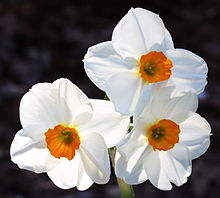Narcissus (pron.: /nɑrˈsɪsəs/) is a genus of mainly hardy, mostly spring-flowering, bulbous perennials in the Amaryllis family, subfamily Amaryllidoideae. Various common names including daffodil, narcissus, and jonquil are used to describe all or some of the genus. They are native to meadows and woods in Europe, North Africa and West Asia, with a center of distribution in the Western Mediterranean. The number of distinct species varies widely depending on how they are classified, with the disparity due to similarity between species and hybridization between species. The number of defined species ranges from 26 to more than 60, depending on the authority. Species and hybrids are widely used in gardens and landscapes.
This flower symbolizing friendship, some of the most popular flowers exclusively due to their unmatched beauty.
Names:
The derivation of the Latin narcissus (from the ancient Greek νάρκισσος) is unknown. It may be a loanword from another language. It is frequently linked to the Greek myth of Narcissus, who became so obsessed with his own reflection that as he knelt and gazed into a pool of water, he fell into the water and drowned. In some variations, he died of starvation and thirst. In both versions, the narcissus plant sprang from where he died. However, there is no evidence for this popular derivation, and the person's name may have come from the flower's name. Pliny wrote that the plant was named for its narcotic properties (ναρκάω narkao, "I grow numb" in Greek). Again, this explanation lacks any real proof and is largely discredited.
Plural:
"Narcissus" is the most commonly used plural, but "narcissi" and "narcissuses" are also acceptable plurals in both British and American English usage.
 Daffodil's Trumpet
Daffodil's TrumpetDaffodil:
The name "daffodil" is derived from an earlier "affodell", a variant of Asphodel. The reason for the introduction of the initial "d" is not known, although a probable source is an etymological merging from the Dutch article "de", as in "De affodil". From at least the 16th century, "Daffadown Dilly", "daffadown dilly", and "daffydowndilly" have appeared as playful synonyms of the name.In common parlance and in historical documents, the term "daffodil" may refer specifically to populations or specimens of the wild daffodil, Narcissus pseudonarcissus.
Description:
Narcissus grow from pale brown-skinned spherical bulbs with pronounced necks. The leafless stems, appearing from early to late spring depending on the species, bear from 1 to 20 blooms. Each flower has a central bell-, bowl-, or disc-shaped corona surrounded by a ring of six floral leaves called the perianth which is united into a tube at the forward edge of the 3-locular ovary. The three outer segments are sepals, and the three inner segments are petals.
Flower colour varies from white through yellow to deep orange. Breeders have developed some daffodils with double, triple, or ambiguously multiple rows and layers of segments, and several wild species also have known double variants.
The seeds are black, round and swollen with a hard coat.
Cultivation:
Narcissus is a popular subject as an ornamental plant for gardens, parks and as cut flowers, providing colour from the end of winter to the beginning of summer in temperate regions. Thousands of varieties and cultivars are available from both general and specialist suppliers. They are normally sold as dry bulbs to be planted in late Summer and Autumn (Fall). Over 140 varieties have gained the Royal Horticultural Society's Award of Garden Merit.
 Narcissus geranium
Narcissus geranium Color Code:
Daffodils may be self-colored—i.e., both perianth and corona identical in color and shade—or the colors between the perianth and corona may differ widely. Some perianths and some coronas may also contain more than one color or shade. Prevalent colors are all shades and tones of yellow, white, orange, pink, red and green. Pinks vary from apricot to rose in shades from pale to deep, and some more recent cultivars have hints of lavender or lilac. Reds vary from orange-red to salmon red to near scarlet. Pink, red, orange and green tones are mainly confined to the corona. However, breeders are currently working against the genus' natural pigmentation and genetic barriers to create cultivars in which pink, rose, red, orange and green tones suffuse or "bleed" from the more highly colored coronas onto the perianth segments of white or yellow. There is an increasing number of commercially available varieties which display this enhanced coloration.
Varieties of Daffodil Flower
